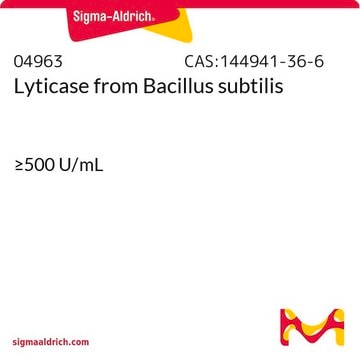The milligram quantity of this product will vary from lot to lot. The vial content is dependent upon the protein content and enzymatic activity. The minimum protein content will be 20% and the minimum activity will be 2000 units per milligram of protein. As an example, a batch that reports a protein content of 20% and an activity of 5000 units per milligram protein will have a vial content of 2 mg for the 10,000 unit package size. The protein content and activity are reported in the product Certificate of Analysis. Please see the link below to review a sample or lot specific Certificate:
https://www.sigmaaldrich.com/product/sigma/l2524#product-documentation
Wichtige Dokumente
L2524
Lyticase aus Arthrobacter luteus
lyophilized powder, ≥2,000 units/mg protein, Protein ≥20 % by biuret
Synonym(e):
Bakterielle Lyticase, Lysierendes Enzym
Größe auswählen
131,00 €
Versandbereit am07. April 2025Details
Größe auswählen
About This Item
131,00 €
Versandbereit am07. April 2025Details
Empfohlene Produkte
Biologische Quelle
bacterial (Arthrobacter luteus)
Qualitätsniveau
Form
lyophilized powder
Spezifische Aktivität
≥2,000 units/mg protein
Zusammensetzung
Protein, ≥20% biuret
Methode(n)
cell based assay: suitable
Eignung
suitable for cell lysis
Anwendung(en)
diagnostic assay manufacturing
Lagertemp.
−20°C
Suchen Sie nach ähnlichen Produkten? Aufrufen Leitfaden zum Produktvergleich
Verwandte Kategorien
Anwendung
- zur Herstellung von Sphäroplasten
- als Komponente der Aufschlusslösung, zur Inkubation von Hefezellen zum Aufschluss der Zellwand
- im Rahmen der enzymatischen Hydrolyse des Myzel-Präzipitats zur Herstellung von Protoplasten
Biochem./physiol. Wirkung
Einheitendefinition
Physikalische Form
Sonstige Hinweise
Signalwort
Danger
H-Sätze
P-Sätze
Gefahreneinstufungen
Resp. Sens. 1
Lagerklassenschlüssel
11 - Combustible Solids
WGK
WGK 3
Flammpunkt (°F)
Not applicable
Flammpunkt (°C)
Not applicable
Persönliche Schutzausrüstung
Eyeshields, Gloves, type N95 (US)
Hier finden Sie alle aktuellen Versionen:
Analysenzertifikate (COA)
Die passende Version wird nicht angezeigt?
Wenn Sie eine bestimmte Version benötigen, können Sie anhand der Lot- oder Chargennummer nach einem spezifischen Zertifikat suchen.
Besitzen Sie dieses Produkt bereits?
In der Dokumentenbibliothek finden Sie die Dokumentation zu den Produkten, die Sie kürzlich erworben haben.
Kunden haben sich ebenfalls angesehen
Protokolle
This procedure may be used for the determination of Lyticase activity using Baker’s yeast as the substrate.
-
How many milligrams is 10,000 units of Product L2524 Lyticase from Arthrobacter luteus?
1 Antwort-
Hilfreich?
-
-
Is it purified downstream by affinity chromatography or is it just an ammonium sulfate precipitate?
1 Antwort-
This product is purified by conventional chromatography following the initial ammonium sulfate precipitation process.
Hilfreich?
-
-
What is the recommended working concentration of L2524, if a typical 10mg/ml concentration of L1412 is used?
1 Antwort-
There have been no tests conducted for product L2524 application on the fungus Aspergillus fumigatus. However, according to a citation in Vet Pathol, 2U/100 ul of fungal extraction has shown good results. The citation is titled "Panfungal Polymerase Chain Reaction for Identification of Fungal Pathogens in Formalin-Fixed Animal Tissues" and was published in July 2017. The DOI is 10.1177/0300985817698207, and the PMID is 28346123
Hilfreich?
-
-
What is the molecular weight of this product?
1 Antwort-
The molecular weight of Lyticase has not been determined.
Hilfreich?
-
-
What is the molecular weight of this product?
1 Antwort-
The molecular weight of Lyticase is not determined.
Hilfreich?
-
-
I see it is suggested to reconstitute Lyticase fresh. However, if that is not possible, can you store reconstituted Lyticase, L2524, at -20C? If so, for how long?
1 Antwort-
The solution stability of this product has not been determined. However, according to Cold Spring Harbor Protocols, lyticase may be stored up to 6 months at 4 deg. C when prepared in 10 mM Tris-CL containing 20% glycerol. This has not been validated. See the link below to this citation:
https://cshprotocols.cshlp.org/content/2017/2/pdb.rec090381.full?rss=1Hilfreich?
-
-
How can I store Product L2524, Lyticase, once reconstituted?
1 Antwort-
When lyticase is reconstituted and stored, it may be stable for no more than 4-6 hours before serious loss of activity is observed. It is suggested that fresh solutions be prepared for use.
Hilfreich?
-
-
How do I solubilize Product L2524, Lyticase?
1 Antwort-
The quality control enzymatic assay protocol for Lyticase uses cold deionized water to make a solution at 500 units/mL.
Hilfreich?
-
-
How can Product L2524, Lyticase, be used to make yeast spheroplasts?
1 Antwort-
The use of lyticase in combination with chitinase and glucuronidase in the preparation of spheroplasts from C. albicans has been described in the following reference: Calvert, C.M., and Sanders, D., "Inositol Trisphosphate-dependent and -independent Ca2+ Mobilization Pathways at the Vacuolar Membrane of Candida albicans". J. Biol. Chem. 270, 7272-7280 (1995).
Hilfreich?
-
-
What is the Department of Transportation shipping information for this product?
1 Antwort-
Transportation information can be found in Section 14 of the product's (M)SDS.To access the shipping information for this material, use the link on the product detail page for the product.
Hilfreich?
-
Aktive Filter
Unser Team von Wissenschaftlern verfügt über Erfahrung in allen Forschungsbereichen einschließlich Life Science, Materialwissenschaften, chemischer Synthese, Chromatographie, Analytik und vielen mehr..
Setzen Sie sich mit dem technischen Dienst in Verbindung.








